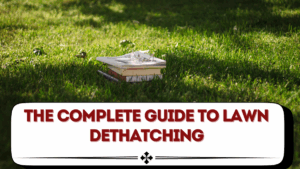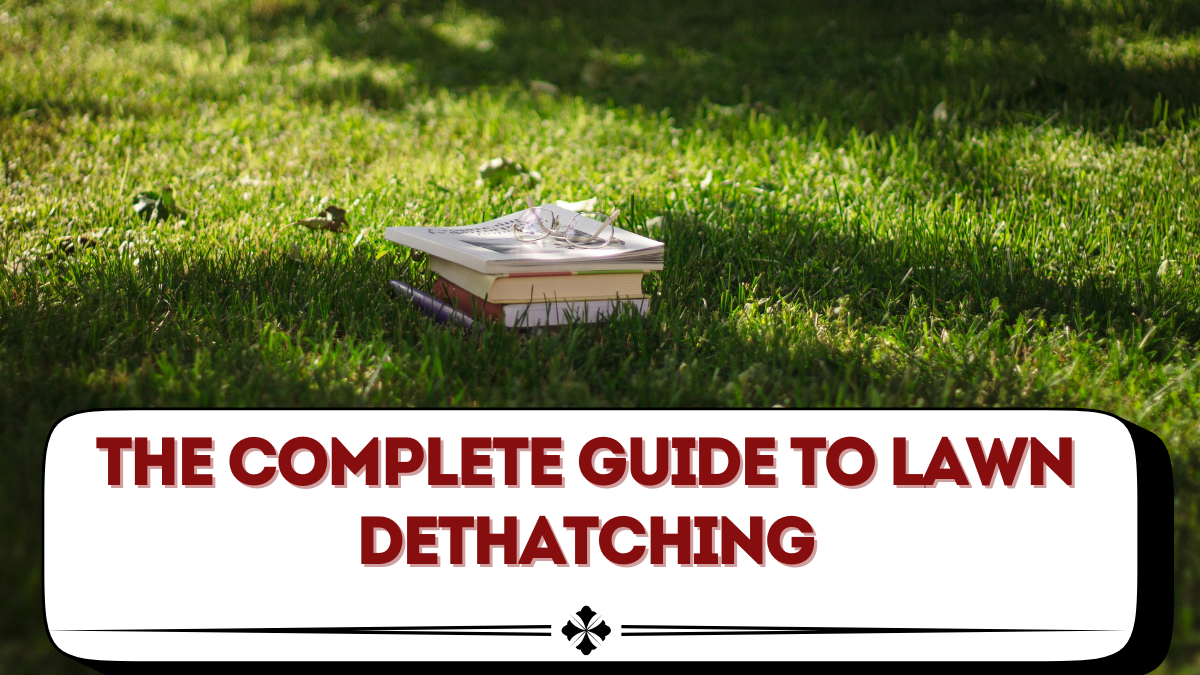A vibrant lawn depends on more than just watering and mowing. One of the hidden factors that can determine lawn health is thatch buildup—a dense layer of roots, stems, and organic debris that accumulates between the soil and grass blades. If left unmanaged, thatch prevents water, nutrients, and air from reaching the roots. That’s why lawn dethatching is one of the most important maintenance practices for keeping grass healthy and strong.
This complete guide explains what thatch is, why dethatching is necessary, the best tools and timing, and how to dethatch your lawn step by step. By the end, you’ll know exactly how to bring back the green, lush appearance your yard deserves.

What Is Thatch?
Thatch is a spongy, brown layer that forms just above the soil surface. It’s made of living and dead grass parts, including stems, roots, and stolons. While a thin layer of thatch (½ inch or less) can actually protect the soil from temperature fluctuations, anything thicker than that can suffocate the grass.
Signs your lawn has excess thatch:
-
Grass feels spongy when you walk on it.
-
Water pools on the surface instead of soaking in.
-
Grass becomes thin, yellow, or patchy.
-
Pests and fungi thrive in the thick layer.
Why Lawn Dethatching Matters
Ignoring thatch can lead to poor grass health and long-term damage. Dethatching allows your lawn to:
-
Improve air circulation to the root zone.
-
Enhance water and nutrient absorption.
-
Prevent pest and disease infestations.
-
Stimulate new grass growth.
-
Strengthen overall lawn resilience.
When to Dethatch: Spring vs Fall
The best time to dethatch depends on the type of grass you have.
-
Cool-season grasses (Fescue, Bluegrass, Rye): Dethatch in early spring or early fall when growth is active.
-
Warm-season grasses (Bermuda, Zoysia, St. Augustine): Dethatch in late spring to early summer when the grass is growing vigorously.
Avoid dethatching during dormancy or extreme heat, as grass will struggle to recover.
Lawn Dethatching Tools: Rake vs Machine
Manual Rake
-
Best for small lawns.
-
Inexpensive and eco-friendly.
-
Requires more physical effort.
Power Dethatcher (Scarifier)
-
Suitable for medium to large lawns.
-
Fast and efficient at removing thick thatch.
-
Available for rent if you don’t want to buy.
Tow-Behind Dethatcher
-
Attaches to a lawn tractor for large properties.
-
Ideal for commercial or large-scale lawn care.
Step-by-Step Lawn Dethatching Guide
-
Check Thatch Thickness
Use a spade to remove a small wedge of turf. Measure the thatch layer—if it’s over ½ inch, dethatching is necessary. -
Prepare the Lawn
Mow the grass shorter than usual (but not scalped). Water lightly a day before dethatching to soften the soil. -
Choose the Right Tool
Select a rake, power dethatcher, or tow-behind tool based on lawn size. -
Dethatch the Lawn
Work in one direction across the lawn. For thick layers, make a second pass at a right angle. -
Collect Debris
Rake up the loosened thatch and compost it if possible. -
Overseed and Fertilize
Overseed thin patches and apply a balanced fertilizer to encourage quick recovery. -
Water and Maintain
Water deeply to help new roots establish. Resume normal mowing practices after a week.
Comparison of Thatch Removal Methods
| Method | Best For | Effort Level | Cost | Effectiveness |
|---|---|---|---|---|
| Manual Rake | Small lawns | High | Low | Moderate |
| Power Dethatcher | Medium–large lawns | Medium | Moderate | High |
| Tow-Behind Dethatcher | Large properties | Low | Higher | Very High |
This comparison shows that while manual rakes work for small yards, most homeowners benefit from power tools for efficiency.
Common Mistakes to Avoid
-
Dethatching too often: Only dethatch when thatch exceeds ½ inch.
-
Wrong season: Dethatching during dormancy weakens grass.
-
Not reseeding afterward: Failing to overseed leaves room for weeds.
-
Using dull blades: This can damage healthy grass rather than just removing thatch.
FAQs
How often should I dethatch my lawn?
Most lawns need dethatching every 2–3 years, depending on grass type and maintenance practices.
Can I dethatch and aerate at the same time?
Yes, dethatching followed by aeration can maximize root growth, but it may stress the lawn if done too aggressively.
Should I dethatch before or after fertilizing?
Dethatch first, then fertilize to ensure nutrients penetrate the soil effectively.
Is dethatching the same as scarifying?
Yes, in many regions the terms are used interchangeably. Both involve removing thatch buildup.
Can dethatching damage grass?
If done at the wrong time or too aggressively, yes. Always dethatch during active growth periods.
Conclusion
Thatch may seem harmless, but when it builds up, it suffocates your lawn and weakens grass health. By following this lawn dethatching guide—checking thatch thickness, using the right tools, and timing it properly—you’ll restore airflow, water absorption, and nutrient delivery. Whether you use a rake for small yards or a machine for larger areas, dethatching sets the stage for a greener, healthier, and more resilient lawn.
Click here to know more.
